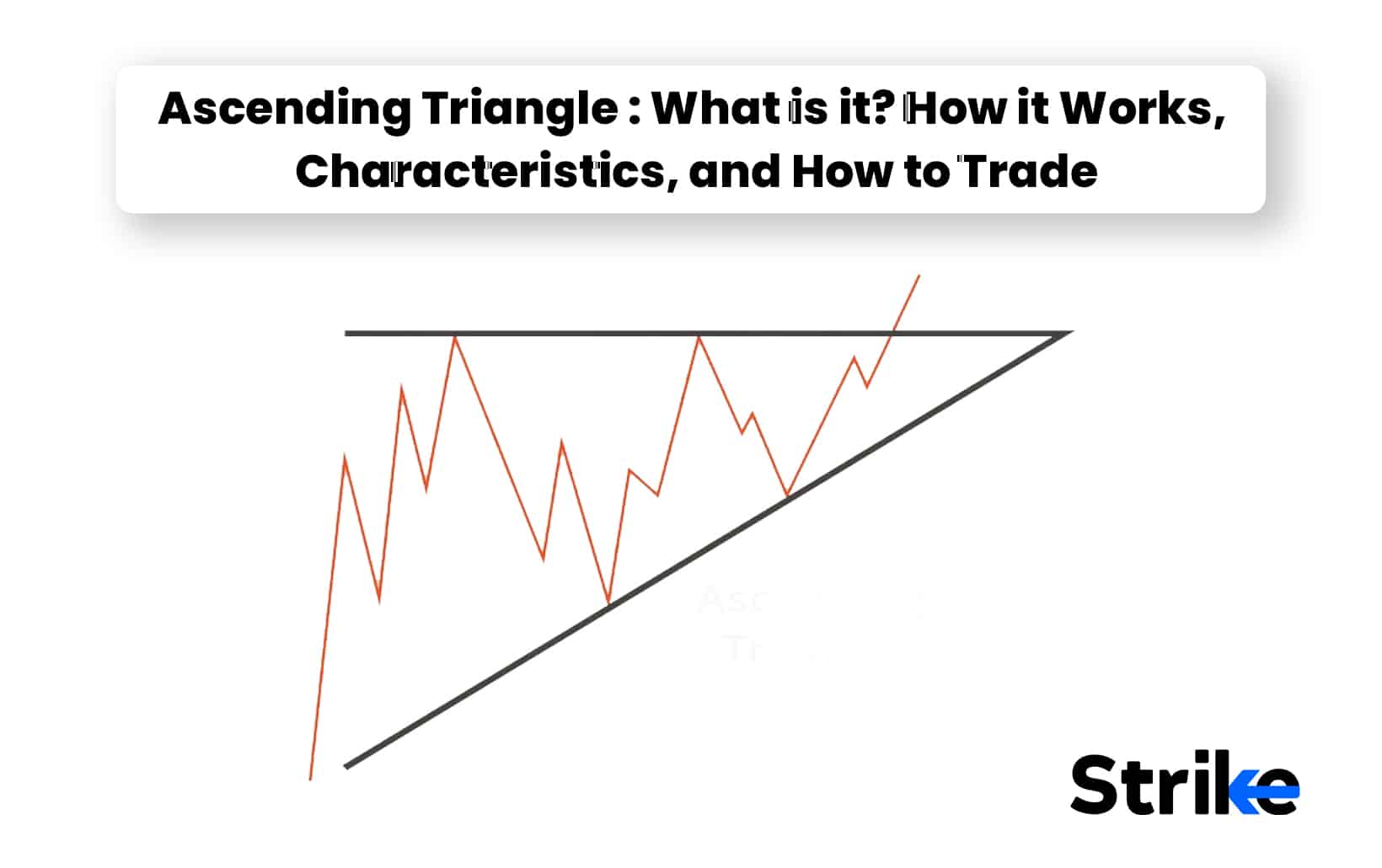
The ascending triangle is a bullish pattern that generally forms as a continuation pattern during an uptrend. Ascending triangles are called continuation patterns because the price moves in the same direction as the trend that existed just before the triangle formation.
An ascending triangle is a breakout pattern that develops when the price breaks through the top horizontal trendline while rising volume. It is a bullish configuration. The upper trendline must be horizontal, indicating similar highs, forming a resistance level. The lower trendline rises diagonally, indicating higher lows as buyers increase their prices. More purchasing occurs as the buyers eventually lose patience and rush into the security above the resistance price as the uptrend resumes. Once acting as resistance, the upper trendline is now acting as support.
The ascending triangle trading strategy is a straightforward approach to taking advantage of breakouts within a trend. The price generally contracts within the ascending triangle pattern; eventually, one of the bears or the bulls wins.
What does an Ascending Triangle Pattern indicate in Technical Analysis?
Ascending triangle patterns are bullish, indicating that when the pattern matures, the price of a security is likely to increase. This pattern has two trendlines. The first trendline is flat and runs along the top of the triangle. It denotes the start or continuation of an uptrend. A line of ascent created by a string of higher lows forms the second trendline, which is the bottom line of the triangle indicating price support. The triangle formed by this pattern is of higher lows, which gives it a bullish interpretation. The primary indication is that the pattern shows that each time sellers try to push the prices lower, they are less successful in their efforts.
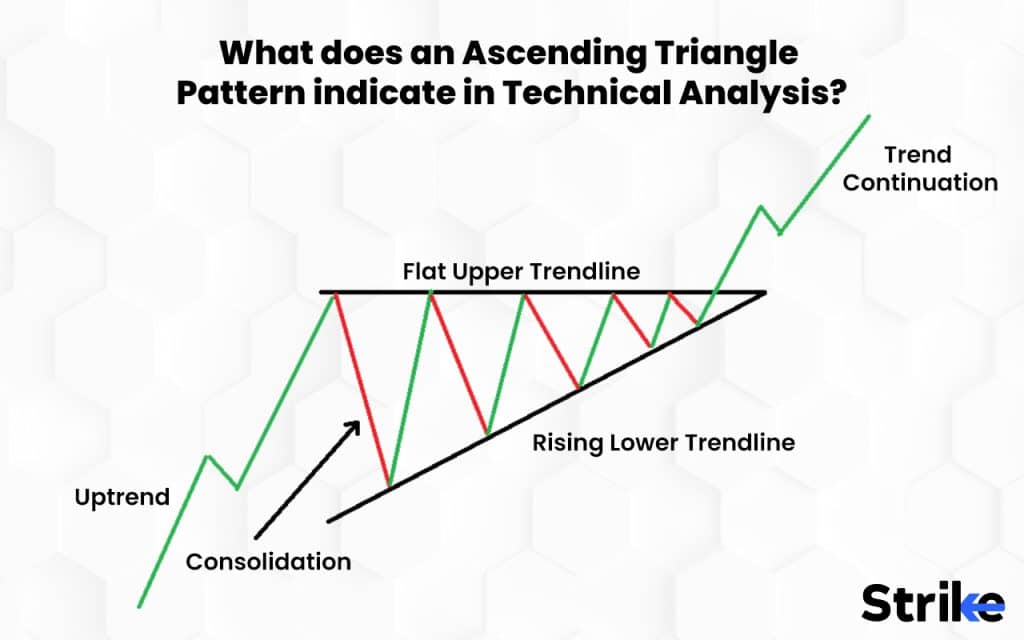
The ascending triangle pattern appears as a security’s price moves up and down between the two lines. Prices rise to a peak, eventually meeting resistance that leads to a decline in price as shares are sold. The fact that each sell-off after hitting resistance ends at a higher level than the last sell-off effort shows that even while the price repeatedly fails to overcome the opposition, this does not give sellers more strength. Eventually, the price overcomes the upward resistance and resumes an uptrend. During technical analysis it indicates an impending market reversal to the upside in case an ascending triangle pattern occurs during an overall downtrend in the market.
How does an Ascending Triangle Pattern work?
The ascending triangle appears as a horizontal support line connecting the highs to a rising trendline that descends to the lows on the price chart. Each ascending triangle has a minimum of two highs and two lows. It contains a horizontal resistance line across the minor highs and a rising trend line connecting the minor lows, forming a triangular pattern.
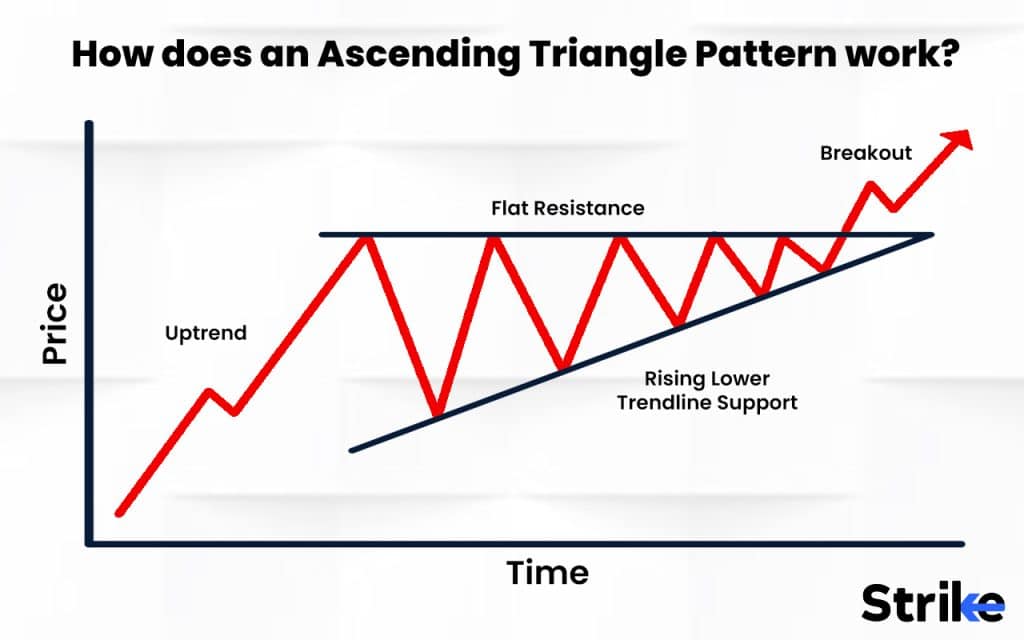
The volume typically decreases throughout the pattern on the chart, just like with other triangular chart patterns. Investors enter when a price breakout occurs while looking for false breakouts. They purchase for an upward breakout and sell for a downward breakout, depending on which way the breakout occurs. The stop loss is positioned just outside the triangle. To calculate the profit target, traders consider the triangle’s height at the maximum width and adjust the measurement as per the breakout price.
The risk/reward ratio of ascending triangles increases as the pattern widens. The stop loss gets reduced for narrower patterns, but the profit target still depends on the most important aspect of the pattern. False breakouts are crucial to consider while using this chart for trading. The price movement oscillates, moving in and out of the pattern in either direction without breaking the upper resistance level.
What is the purpose of an Ascending Triangle Pattern?
The purpose of an ascending triangle pattern is to help traders identify potential bullish breakouts in a stock’s price. This pattern is formed when the stock’s price creates a series of higher lows, while the upper boundary of the pattern remains relatively flat. This indicates that there is a significant level of buying pressure building up, and if the stock is able to break through the upper boundary of the pattern, it could be a signal to enter a long position. Traders typically look for high trading volume when the breakout occurs to confirm the validity of the pattern.
How does an Ascending Triangle Pattern form?
Ascending triangle is formed by the price movements that permit the drawing of a horizontal trendline along the swing highs and a rising trend line along the swing lows. They intersect to form a triangle. Traders frequently look for triangle pattern breakouts. Either an upward or downward breakout is possible.
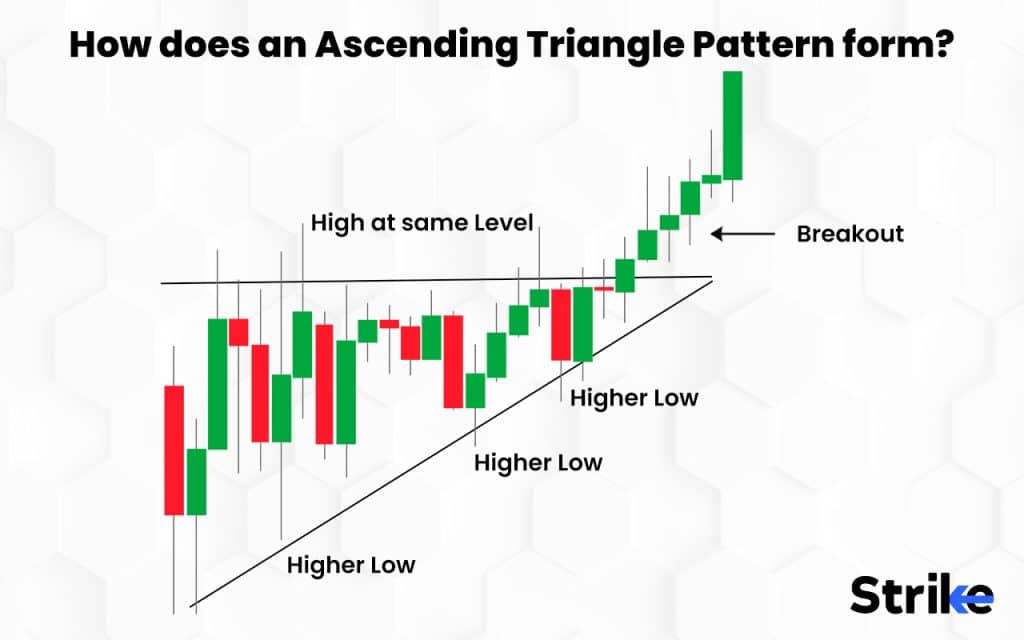
Ascending triangles form following an uptrend, and the pattern denotes the continuation of an uptrend. A stock should experience a suspected rising triangle after making significant gains before encountering resistance.
The area of resistance creates the upper line of an ascending triangle. This resistance area undergoes multiple testing for the pattern to form. The more times the resistance area is tested and not broken through, the stronger the eventual breakout.
A stock’s price in an ascending triangle pattern oscillates between the testing area and setting a series of lows, each one higher than the price of the previous low. The rising trendline made by these lows are periodically tested as the pattern develops.
An ascending triangle pattern is complete when there is a bullish breakout above the resistance region. This breakout should appear on above-average volume. The price difference between the resistance line and the lowest low at the start of the triangle pattern is similar to the expected magnitude of the breakout over the resistance line.
How does an Ascending Triangle Pattern differ from other Triangle Patterns?
A triangle is a chart pattern that denotes a pause in the current trend. It is represented by trendlines drawn along a converging price range. Triangles are categorised as continuation patterns by technical analysts.
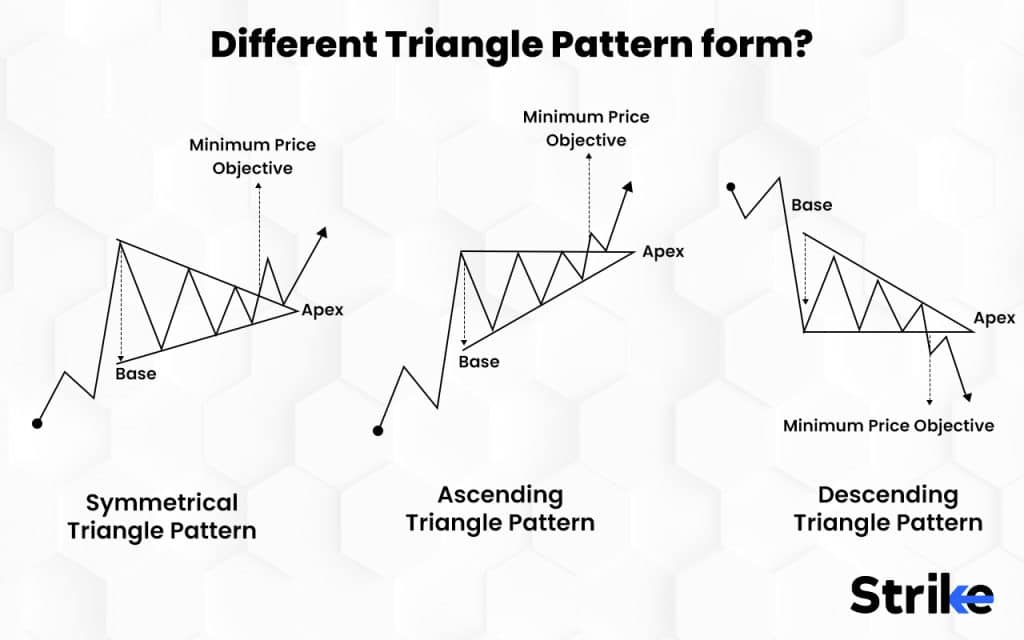
Ascending triangle pattern is one of the three primary triangle patterns, along with the symmetrical triangle pattern and descending triangle pattern.
An ascending triangle is a chart pattern used by traders in technical analysis. It is a bullish formation that predicts an upward breakout. It has a flat top with higher lows or a rising trendline.
A descending triangle pattern is a sequence of lower highs and a lower resistance level. It is a bearish pattern. Two trendlines, one for high prices and one for low prices, combine to form the descending triangle.
A symmetrical triangle is a chart pattern consisting of two trend lines that converge and link a sequence of peaks and troughs. These trend lines converge at a roughly equal slope.
What are the Characteristics of an Ascending Triangle Pattern?
The ascending chart pattern is characterised by a horizontal trendline drawn along the swing highs and a rising trend line drawn along the swing lows.
Another characteristic of an ascending triangle is that it provides a clear entry point, profit target and stop loss. A trader enters the position on the long side if the horizontal line turns to the upside. The lower trendline would serve as the stop-loss in this case. The triangle’s widest point would be the target.
A short entry is made, with a stop-loss placed above the horizontal line, if a breakout occurs below the ascending trendline. Once more, the broadest portion of the rising triangle would serve as the target.
The narrow width of the ascending triangle at the moment of completion makes the stop-loss relatively small, making an ascending triangle a high reward-to-risk trade.
What is the accuracy of Ascending Triangle Pattern?
The likelihood of an accurate breakout when using Ascending Triangle Pattern is usually higher when the pattern takes longer and the volume is higher during the breakout.
Traders should be aware of false breakouts, in which the price briefly breaks above the resistance level but falls back below it. It is essential to confirm the breakout with high volume and watch for possible retests of the breakout level to get more accurate results.
How successful is Ascending Triangle Pattern?
Ascending triangles have a good success rate, but there is still a lot of possibility for fake signals. An increase often indicates power. A flat volume trend, on the other hand, suggests that the breakout or collapse could not have enough momentum. Placing stop-losses on the opposite side of the trend is a method traders use to lower the risk in a potential ascending triangle breakout. In the event that the trend changes before the technical profit target is reached, traders exit their positions at a reduced loss.
How to trade using an Ascending Triangle Pattern in the Stock Market?
Ascending triangle patterns are easy to spot on stock charts. Traders must recognise the upward trend. The ascending triangle starts to appear as the candlestick consolidates. Once the triangle has formed, traders use the measurement strategy while waiting for the breakout.
1.)Uptrend: The market should be in an uptrend before the ascending triangle appears. This is essential and highlights that traders should not simply trade the pattern each time an ascending triangle arises.
2.)Consolidation: The rising triangle takes shape as the market moves into the consolidation phase.
3.)Rising lower trendline: A rising trendline is created by joining the lows while the market consolidates. An ascending trendline supports a positive trading bias by demonstrating that buyers gradually increase prices.
4.)Flat upper trendline: The upper trendline serves as resistance; the price frequently approaches it and bounces off it before the breakout finally occurs
5.)Trend continuation: Traders look for confirmation of the pattern via continuous upward momentum when the price registers a significant break above the upper trendline.
Stock market traders open a long position after observing a solid break above resistance, establishing a stop at the most recent swing low and a take profit target in line with the measuring technique.
What is the best way to Trade an Ascending Triangle Pattern?
The best way to trade ascending triangle patterns is to trade the resistance level’s breakout or the support level’s breakdown. The first happens when the previous trend is an uptrend, while the second occurs when the prior trend is a downtrend.
What is an example of an Ascending Triangle Pattern used in Trading?
Let’s look at an example of an ascending triangle pattern on the daily chart of Apple Inc. stocks.
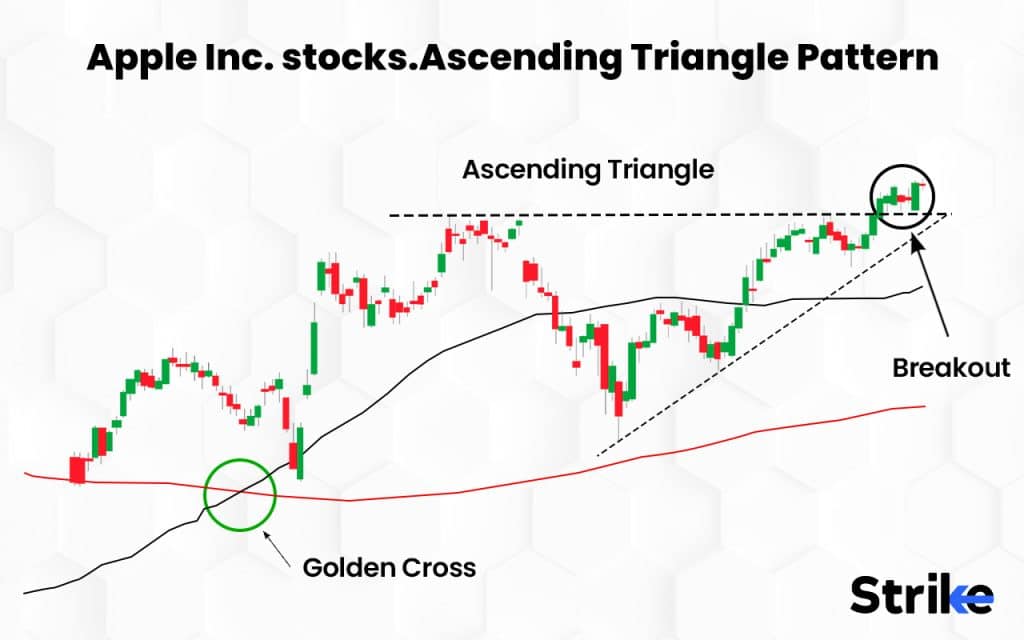
A long-term bullish trend in the market begins after a downtrend. An ascending triangle with a flat resistance level and an ascending support line forms on the price chart, as you see in the chart above. The bulls try to overcome the resistance level made by the bears several times by squeezing the price upwards from the bottom. Buyers were then able to cross the ceiling and go higher, as a result, giving the pattern a price-springing effect.
The asset accumulated at the same level briefly following the impulse breakout of the resistance signifies that the bulls established a new base for the subsequent rise. The market then tests the breakout price level and keeps growing rapidly.
The height of the pattern, that is, the distance between the low point of the support level and the high point of the resistance level, determines the price movement along it.
What are the potential bullish signals of an ascending triangle pattern?
The potential bullish signals of the ascending triangle pattern are higher lows, resistance levels, decreasing volume, Breakout, and price target.
Higher lows: A sequence of higher lows is seen in the ascending triangle pattern, indicating buyers are becoming more active and willing to pay greater prices.
Resistance levels: A horizontal resistance level connecting multiple highs is also present in the pattern, indicating that buyers are becoming more confident and want to push the price to higher lows.
Decreasing volume: The volume tends to decline as the price gets closer to the resistance level, indicating that sellers are losing power and buyers are gaining control.
Breakout: The pattern indicates a probable bullish breakout and the continuation of the rising trend if the price breaks above the resistance level. Traders use this breakout as a buying opportunity.
Price target: By measuring the distance between the horizontal resistance level and the highest point of the triangle and adding it to the breakout level, one calculate the price goal for an ascending triangle pattern. This gives a rough target for the price’s upward movement.
It is crucial to remember that ascending triangle signals do not ensure a profitable trade, even though they point towards a potential bullish continuation. To support their trading choices, traders should perform their own analysis.
What are the potential bearish signals of an ascending triangle pattern?
The potential bearish signals of an ascending triangle pattern are false breakout, lower highs and price targets.
False breakouts: A false breakout occurs when the price rises above the resistance level but cannot maintain the upward momentum and falls back below the resistance level. This could signal a potential reversal and be a bearish signal.
Lower highs: A bearish reversal occurs if the price forms a set of lower highs instead of higher lows, indicating that the sellers are taking control and the buyers are losing momentum.
Traders should consider the potential bearish signals of the ascending triangle pattern to reduce the risks involved before trading.
How Does Volume Affect Ascending Triangle Patterns?
Volume is crucial in determining the strength of an ascending triangle breakout or breakdown, just like it is for any support/resistance or trendline breakout/breakdown. The volume must be low or below average as the ascending triangle reaches near completion, and when the breakout occurs, the volume should be strong, signifying that huge money is backing the move.
How long does Ascending Triangle Pattern last?
An ascending triangle pattern will take about 28 days to form and will not last for more than 90 days. Most analysts enter a trade whenever the stock price increases by an amount equal to the triangle’s largest part, and price action breaks through the triangle’s top line with increasing volume.
What are the Benefits of Trading an Ascending Triangle Pattern?
The benefits of trading an ascending triangle pattern are that it appears in any timeframe, is used in any financial instrument, is easy to detect, and does not need any complicated indicator.
Appears in any time frame: Every timeframe, including both long-term and short-term ones, can exhibit an ascending triangle pattern. Also, a lot of traders employ this pattern during day trading.
Used in any financial instrument: Every financial instrument is traded using the ascending triangle. The pattern is present in the stock market and the foreign exchange, cryptocurrency, and commodities markets.
Easy to detect: The pattern is easy to spot and trade, and there are clear criteria for entering and exiting a trade, so even beginners can use it.
No need for complicated indicators: An ascending triangle pattern does not require any complex indicators or extra equipment to trade. Knowing the fundamental principles of pattern generation and its defining characteristics is sufficient.
The ascending trading pattern proves beneficial even for those new to trading, as it is easy to interpret.
What are the Limitations of an Ascending Triangle Pattern?
The limitations of an ascending trading pattern are that it is only sometimes accurate, it takes a long time to appear, confusing with other patterns.
Not always accurate: The ascending triangle pattern, especially when it forms during a downtrend, does not usually provide reliable signals. Bulls sometimes have the strength to raise the price during a decline because trade volumes are declining.,Aa bullish trap for buyers is developed in the chart, which gives a false signal to buy, causing false breakouts.
Long time to appear: The triangle’s structure takes some time to form on the chart before the pattern’s ideal entry point appears. There is a chance of missing a good entry point during an upward impulse breakout of the resistance level by the price; therefore, it is preferable to utilise pending orders to buy while trading.
Confusing with other patterns: There is a chance that the ascending triangles pattern will be mistaken for the rising wedge, a bullish-to-bearish reversal pattern since it rarely appears on the price chart.
Traders must consciously consider these limitations of the ascending chart pattern and trade to avoid losses.
What Are the Common Mistakes Traders Make While Trading an Ascending Triangle Pattern?
The biggest mistake traders make is entering the market before the triangle’s break. According to the snapshot below, based on the prior triangles and momentum analysis, one anticipated a break to the downside as the highs were coming in rapidly, and the price quickly pushed to the bottom trendline.
But, it did not occur, and the price rose over the triangle’s lower line. This demonstrates how triangles could be better and will fail. Additionally, a triangle’s actual signal arises after breaking the trendline. A break of the trendline is only legit after the price closes outside the triangle and remains outside it.
Is an Ascending Triangle Pattern bullish?
Yes, the ascending triangle pattern is a bullish continuation pattern. It is characterised by a flat upper line that acts as support and a rising lower trendline.
Can an Ascending Triangle Pattern be bearish?
No, ascending triangle patterns cannot be bearish. Descending triangle patterns opposite to ascending triangle patterns are bearish continuation patterns.
Are Ascending Triangle Patterns Reliable?
Ascending triangles are most reliable when found in an uptrend. The horizontal line gets more distinct, and the ascending triangle pattern is more reliable when there are more swing highs. These swing highs should be seen to be around the zone rather than having to match the horizontal resistance exactly.




![85 Common Stock Market Terminologies for Dummies [Updated List for 2026] 34 85 Common Stock Market Terminologies for Dummies [Updated List for 2025]](https://www.strike.money/wp-content/uploads/2025/04/Popular-Stock-Market-Terms-for-Beginners-Banner.png)










No Comments Yet.